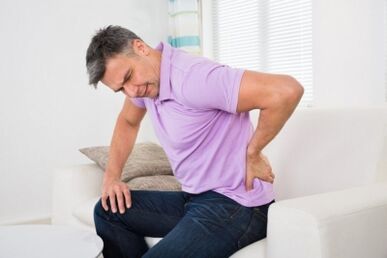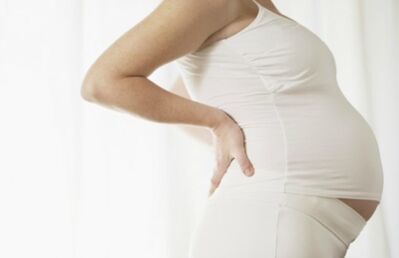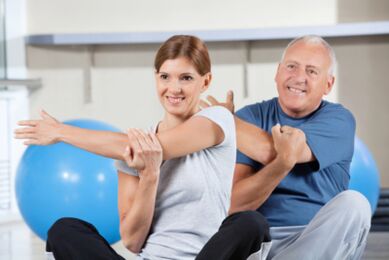
Many people ask this question due to the fact that it is the lower back that is most often subjected to extreme loads throughout a person’s life.In many cases, this is what provokes the appearance of osteochondrosis or exacerbates its condition.If you start this disease, it can become a serious problem, so it is so important to conduct diagnostics in time and start treatment.In the article you will find everything about what this disease is, what are its causes and symptoms, as well as the treatment of the disease.
Reasons
The main causes of lumbar osteochondrosis are:
- flat feet;
- scoliosis;
- mechanical injuries of the lower back;
- metabolic violation;
- sedentary lifestyle;
- obesity;
- violation of the water-salt balance;
- improper nutrition;
- pregnancy.
Important!The reasons for the appearance of problems with the lumbar department have not been studied to the end.This means that in a specific situation it can be difficult to determine what exactly provoked the appearance of the disease.
Symptoms
There are several subspecies of osteochondrosis, therefore, symptoms of the disease may vary slightly.Next, we will analyze each subspecies and characteristic signs.
Polysegmenting - what is it?
Polishensic osteochondrosis (PSO) is a defeat of several segments of the spine at the same timeDegenerative processes.
Signs:
- Strong pain in the lumbar region.
- With sharp movements or attempts to raise something heavy, “shots” appear.
- It becomes difficult to perform the usual motor actions.
Protrusion
Protency is one of the stages of osteochondrosis, during which the elasticity and height of the intervertebral discs decreases.Because of this, the cartilage begins to gradually stick out beyond the borders of the vertebrae.
Signs:
- stitching pain that can appear not only when moving, but also at rest;
- easy numbness of the lower extremities;
- PARETHING or redness of the skin of the lower extremities;
- the appearance of weakness in the legs;
- long sitting or standing leads to pulling pain, which disappears after the change of posture;
- When lifting heavy things, a sharp pain can be given to the basin and hips.
Intervertebral disk hernia L5-S1
The appearance of a hernia is the last stage of osteochondrosis.This problem is characterized by a strong protrusion and loss of the intervertebral disc, which does not withstand the pressure of the vertebrae surrounding it.

Signs:
- Pain syndrome, which applies not only to the lower back, but also to one of the lower extremities.
- The appearance of pain in one of the buttocks and a leg related to it.
- Strong numbness or tingling in the lower extremities.
- Strengthening numbness and pain in a vertical position and during movement.
- Reducing the amplitude of movements in the lower back.
- Sailing foot syndrome.
- Changing gait and posture.
- Strong pale or redness of the skin in the lower back and on the legs.
- In rare cases, urinary or feces arise.
Psychosomatics in women and men
Psychosomatic disorders appear due to suffered emotional injuries.Signs of this disorder depend on the stage of osteochondrosis, and are no different from the previously described.
Important!When a psychosomatic disorder occurs, the patient should be treated with a neuropathologist and a psychotherapist in order to achieve a maximum positive effect.
Do they take the army with a diagnosis?
Lumbar osteochondrosis belongs to the category of suitability "B".This means that the young man has serious health problems that do not allow him to undergo military service.To obtain this category, the young man should have the following deviations:
- intervertebral hernia;
- severe pain from physical exertion;
- Notable on the x -ray deformation of the vertebrae and intervertebral discs.
Stages
Lumbar osteochondrosis has 4 stages(or, as they are also called - degree: 1, 2, 3 and 4), each of which is characterized by certain degenerative processes.
Degenerative changes in each stage
- 1-2 stage.At 1 stage, a fibrous ring is deformed due to the intra-discharge displacement of the nucleus, which occurs stronger than normal.At 2 stages, a crack of the fibrous ring appears, which leads to instability of the spinal segment.
- 3-4 stages.At 3 stages, the intervertebral disc is completely bursting, which leads to a disk loss.At 4 stages, a dystrophic lesion of the intervertebral disc and spondylosis appears.
Diagnostics
To make an accurate diagnosis, the doctor must conduct a number of tests that include:
- Primary inspection (palpation, visual inspection, checking the level of physical activity).
- Radiography.
- Computed tomography (CT).
- Magnetic resonance imaging (MRI).
Reference.Among all methods of diagnosis, MRI is considered the most modern and effective.The problem is that such a device is not in every hospital, and most often MRI has to be done in private clinics or wait long for your turn.
Various stages and varieties of lumbar osteochondrosis have their own characteristics, therefore, for their diagnosis, there are also their nuances.
With a root syndrome
Typically, rooster syndrome appears in the last two stages of the disease.The syndrome is characterized by damage to the nerve roots that come out of the spinal cord.They innervate and control the functioning of the muscles in the lower back, the genitourinary system and the intestines.Therefore, the spine syndrome of the lumbar region leads to problems with these systems.
Communication with the deformation of the intervertebral disc
The rooser syndrome appears in the last stages of osteochondrosis due to flattening of the intervertebral disc and squeezing the nerve roots with vertebrae.MRI is best for the diagnosis of this disorder, as this procedure allows you to see all changes in soft tissues.

During pregnancy and breastfeeding
If a woman leads a sedentary lifestyle, suffers from flat feet, or has a genetic predisposition, the likelihood increases that during pregnancy she will have osteochondrosis.
For pregnant women, this disease is dangerous not only by attacks of pain, but also by the fact thatIt can lead to a decrease in the size of the pelvic bone.Because of this, a cesarean section will be required.
Unfortunately, to diagnose osteochondrosis using MRI, CT or X -ray before treating it, during pregnancy is prohibited.Therefore, treatment is prescribed empirically.If a woman has already given birth, but still continues to feed her breasts, the hardware diagnostic method is also contraindicated.
With protrusion
When the protrusion of the intervertebral disc appears, X -ray will not be able to show large results, since deformation occurs only with a fibrous ring and a core.
A study is required with the help of MRI, which scans precisely soft tissues and can reveal a variety of degenerative changes.
Complications and consequences
If you do not treat lumbar osteochondrosis, it can lead to a deterioration in health and the development of other diseases.
Why is the disease dangerous?
At 4 stages of the disease, such irreversible changes begin to appear as:
- Violation of spinal circulation.
- Problems with intestinal emptying.
- Reducing sensitivity in the area of the groin and anus.
- Weakness in the lower extremities.
- Frequent urination.
- Paralysis of the lower extremities.
- Reducing mobility in the lower back.
- Spasmodic muscles of the lower back and legs.
Concomitant diseases
- radiculitis;
- compression-vascular ischemia;
- compression myelopathy;
- sciatica;
- lumbago.
Treatment and rehabilitation
Now that you know what kind of disease this is, we will talk about how to treat it.After diagnosticsThe doctor prescribes a course of treatment depending on the stage and form of osteochondrosis.
Orthopedic devices for the lower back
In order to reduce the pain syndrome and muscle tension in the lower back, the patient is offered to wear a special orthopedic corset.
He covers the entire lower back, maintaining the muscles, vertebrae and ligaments in the correct position, removing excessive tension from them.
Medicines
Medicines are one of the important aspects of therapy for lumbar osteochondrosis.Usually 5 groups of drugs are used.In normal mode, it can be ointments or tablets.If the patient is overtaken by severe attacks of pain, a drug blockade is performed.

Drugs
The main groups of drugs for osteochondrosis:
- PainkillersIn the form of tablets or ointments.
- Anti -inflammatory.Also used in the form of tablets or ointments.
- Musorelaxants- drugs that reduce muscle spasm.
- Chondroprotectors- drugs that restore bone and cartilage.
- Vitamins.Basically, group B is used for osteochondrosis, so they help improve metabolic processes in affected tissues.
Do not try to choose medicines yourself.All drugs should be prescribed only by the doctor.
Medication blockade
The blockade is the introduction of drugs using a syringe directly into the affected area of the spine.This is necessary when an acute pain syndrome appears to reduce discomfort and restore the usual level of physical activity of the patient.
Physiotherapeutic methods
Physiotherapeutic methods are often used to restore the spasmodic muscles and affected tissue of the lower back.Magnetotherapy is especially relevant among them.
Magnetotherapy
This procedure stimulates metabolic processes, blood circulation, improves the work of the endocrine and nervous system.The method can be very painful, but quite effective.
You can improve the patient's condition with magnetotherapy in 3-4 weeks.
Massage
Massage relieves pain and muscle spasm.It is carried out only by a specialist with medical education.Most often, a course for 10-12 sessions is prescribed.The final decision on the duration of therapy is made by the masseur.
Manual and acupuncture
Manual therapy eliminates pain and increases the volume of movements in the lumbar region.This is due to the improvement of biomechanics of the musculoskeletal system, blood circulation and metabolic processes.The acupuncture has a similar effect, but acts pointily on the affected areas of muscles.
Therapeutic gymnastics
Exercise therapy is one of the most effective ways to combat unpleasant consequences of osteochondrosis for vertebrae.Before starting classes, consult an exercise therapy instructor.

What can and can not be done?
During exercise therapy, it is prohibited:
- make sharp movements;
- greatly bend in the lower back;
- Sharply increase the amplitude of movements.
In exercise therapy, it is allowed:
- make smooth movements;
- use inventory (benches, gymnastic sticks, dumbbells);
- do exercises for the flexibility of the lumbar region.
Author's technique of the doctor
The doctor developed a methodology for his sore spine.When he realized that his exercises have a positive effect on the sore back, he began to share them with his patients.
The following are the three simplest and most effective exercises from gymnastics:
- For warm -up: Set on all fours and walk in this position around the room for 5-7 minutes.Pre -wrap the knees with protective bandages.
- The main exercise.Standing on all fours, bend in a breath.Bend your back on the exhale.Repeat 5-8 times.
- Stretching.Standing on all fours, smoothly go back, touching the buttocks of the heels.Repeat 3-4 times.
Yoga and Pilates
Pilates was designed specifically for the restoration of pilots who received back injuries, so the system works perfectly with spinal osteochondrosis.It is necessary to engage in this system only under the supervision of an instructor.
Yoga has many directions, and also suitable for working with a sick spine.
Such classes are allowed only during the period of remission, as they have high intensity.
Folk remedies at home
Preparation of ointment at home
You will need:
- coconut oil - 50 gr.;
- Bee wax - 2 s.L.;
- camphor - 1 s.L.;
- Essential oil of peppermint, arnica and cloves.
How to cook:
- Mix coconut oil, bee wax, camphor and heat the mixture in the microwave for 1 minute.
- Add 9 drops of mint, 7 drops of arnica and 5 drops of clove oil, then stir the mixture.
- Place the ointment in a glass jar for storage.
Finishedrub the lower back 2 times a day with ointment, until the pain decreases.

Honey and potato compress
You will need:
- 50 gr.honey;
- 1 large potato.
Grate potatoes on a large grater, mix with honey and grate your back with a mixture.Put the waxed paper on top and wrap the lower back with a warm cloth.The compress must be left all night.Repeat the procedure until the pain in the back passes.
Ginger ointment
You will need:
- ground ginger - 2 tsp;
- honey - 1 tsp;
- Carkuma ground - 1 tsp;
- Black pepper - 0.5 tsp.
Carefully mix all the ingredients and apply a thin layer of ointment on your back.On top, apply warm fabric.If he burns hard, gently rinse off the ointment with warm water.
Baths with herbs
You can use the following herbs:
- chamomile pharmacy;
- fennel;
- AIR;
- thyme;
- sage.
Mix 20 grams of all plants and prepare a medicinal decoction.When you take a bath, add a finished decoction to it.You can use this recipe 1-2 times a week.Herbs relieve tension and pain in the lower back.
Surgery
This method of treatment is used in rare cases if conservative methods of treatment are ineffective.During the operation, the part of the cartilage that went beyond the vertebra is removed.
If the intervertebral disk is damaged too much, it is replaced by an artificial one.
Forecasts
The prognosis can only be given by the attending physician, since each person occurs individually.It all depends on the neglect of osteochondrosis and the general condition of the patient's body.
What to do with exacerbation?
During the aggravation period, it is necessary to exclude all physical activity, use drugs and wear a warming waist bandage.In addition, you need to consult your doctor, who will give more detailed recommendations.

Prevention
How to prevent chondrosis?
Since you cannot influence genetic abnormalities and hereditary predisposition, it will not work to completely protect yourself from the appearance of chondrosis.
Butin your power to observe the correct regime of the day and nutrition, show more physical activity and abandon bad habits.
All these tips will help maintain the health of the spine as long as possible.
Sick leave
The neuropathologist prescribes sick leave only with an exacerbated form of the disease, accompanied by severe pain, which usually begin at 2 and 3 stages of osteochondrosis.
How many days do they give?
As a rulesick leave with lumbar osteochondrosis is given no more than 7 days.
Councils of specialists
If you notice the first signs of discomfort in the lower back, when you raise something heavy or simply with active movements and twisting, do not tighten with diagnostics.
The sooner you start treatment, the easier it will be to cope with the disease and avoid unpleasant health consequences.
Many are accustomed to perceive lumbar osteochondrosis, as something granted.But this disease can progress, which will eventually bring a lot of unpleasant consequences to the patient.Remember that you yourself are responsible for your health, not doctors, and if you find signs of osteochondrosis, start the treatment as quickly as possible.
























